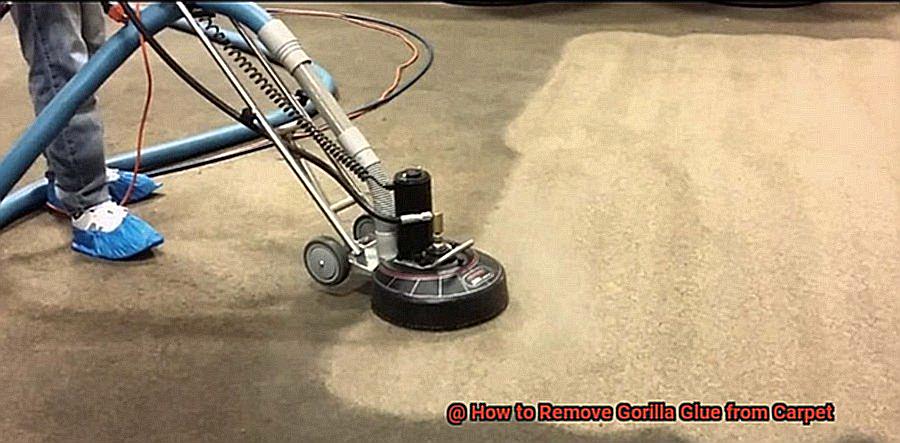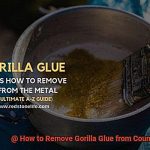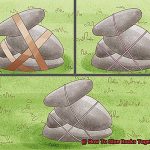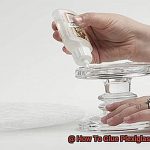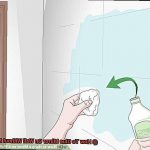Have you ever been in a DIY project or repair that involved using Gorilla Glue? If so, you know how strong and durable this adhesive can be. But what happens when it accidentally spills on your carpet? The frustration of trying to remove it can be overwhelming.
But don’t worry. In this article, we’ve got you covered with effective methods on how to remove Gorilla Glue from carpet. Whether it’s a small drop or a large puddle, these techniques will help you get rid of the stubborn glue from your carpet.
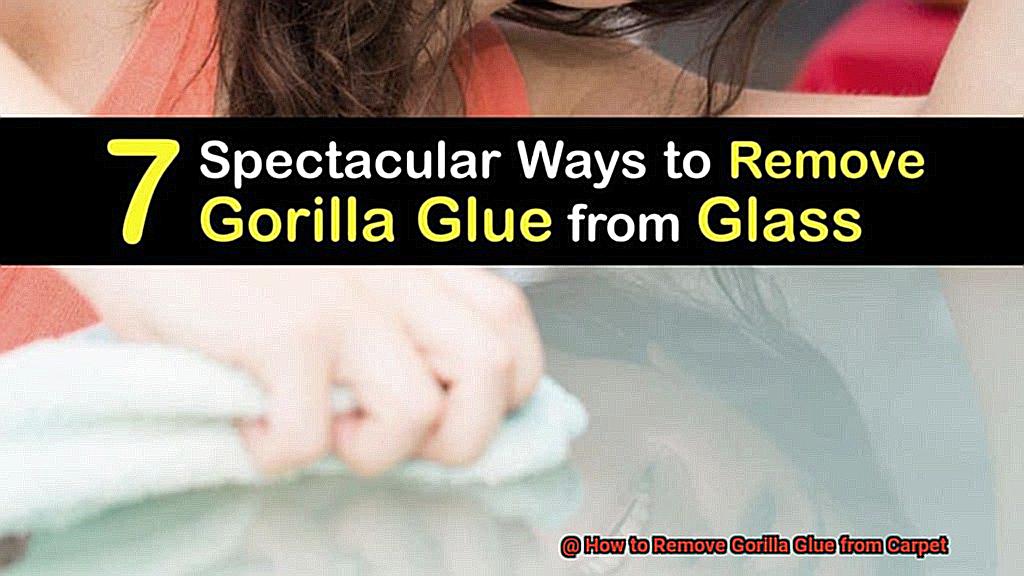
Acting fast is crucial when dealing with spills. The longer you wait, the harder it becomes to remove the glue. We’ll also discuss the tools needed for the job such as gloves, scraper and cleaning solutions.
We’ll delve into three different methods for removing Gorilla Glue from carpet: hot water and dish soap, acetone, and rubbing alcohol. With step-by-step instructions and tips on how to use each method effectively, you’ll soon have all the knowledge and confidence needed to tackle any spill.
In this article, not only will you have successfully removed Gorilla Glue from your carpet but also without causing any damage. So let’s dive in and get started.
How to Remove Gorilla Glue from Carpet
Act Fast to Remove Gorilla Glue
First, grab a clean cloth or paper towel and blot up as much excess glue as possible. Then, gently scrape away any remaining glue with a plastic scraper or spoon. Be careful not to damage the carpet fibers as you scrape.
Next, soak a clean cloth in warm water and place it over the glue stain for about 10 minutes. This will help loosen up the glue and make it easier to remove. After 10 minutes, use a dry cloth to blot up as much of the glue as possible. Remember, blotting is key here – avoid rubbing as this can push the glue deeper into the carpet fibers.
If there’s still some stubborn glue left on the carpet after blotting, don’t worry – you can try using acetone or rubbing alcohol to break down the glue. But before you do, it’s important to test any cleaning solution on an inconspicuous area of your carpet first to make sure it won’t damage or discolor it. Once you’re ready to go, apply a small amount of acetone or rubbing alcohol onto a clean cloth and dab it onto the glue stain. Let it sit for a few minutes before using a clean cloth to blot up the glue and cleaning solution.
Now, it’s important to note that Gorilla Glue is a strong adhesive and may not come out of your carpet completely. If you’re still left with a stubborn stain, it’s best to call in a professional carpet cleaner for assistance.
But with these simple steps and some patience, you can effectively remove Gorilla Glue from your carpet without causing any damage or discoloration.
Scrape Away Remaining Glue
Great job on removing the excess Gorilla Glue from your carpet. But don’t celebrate just yet because the next crucial step is to scrape away any remaining glue. However, proceed with caution to avoid damaging your carpet fibers.
To start, choose a plastic scraper or a spoon. Remember not to use sharp objects that could cut into your carpet fibers and cause further damage. Gently scrape away as much glue as possible without being too aggressive.
If the glue is stubborn and won’t budge, no worries. You can dampen a cloth with warm water and place it over the glued area for a couple of minutes. This will soften up the glue, making it easier to scrape away without damaging your carpet.
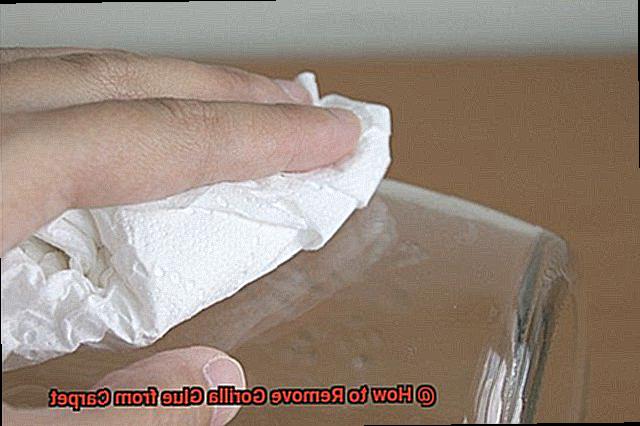
Congratulations on your hard work so far. You’ve successfully removed the excess glue and scraped away as much as possible without causing any further damage. However, there may still be some residual glue left over, but don’t worry; we’ve got you covered in our next section.
Apply Acetone or Nail Polish Remover
Before you dive in with these powerful solvents, it’s important to note that they can cause damage to some types of carpet fibers. So, let’s go through how to apply acetone or nail polish remover safely and effectively.
To start, dampen a cloth or cotton ball with the solution and apply it to the affected area. But don’t go overboard – too much solvent can damage your carpet. Gently blot the area with the cloth, working from the outside inwards. This will help dissolve and lift the glue out of your carpet fibers.
If you find that the glue isn’t budging after a few attempts, repeat this process several times until you’ve removed as much of the glue as possible. Once you’re satisfied with your progress, rinse the area thoroughly with water to remove any remaining residue.
Now, here’s an important tip: acetone should only be used on synthetic carpets. Natural fibers such as wool or silk are too delicate for the harshness of acetone. And remember to use acetone in a well-ventilated area away from any sources of heat or flame.
Acetone or nail polish remover can be a game-changer in removing Gorilla Glue from your carpets. But always proceed with caution and only apply them to synthetic carpets. If you’re unsure about whether it’s safe to use acetone on your carpet, contact a professional carpet cleaner for guidance.
Gently Rub the Affected Area
With the right approach, you can get rid of the glue and restore your carpet to its former glory. One crucial step in this process is gently rubbing the affected area.
As you rub the area with a clean cloth or sponge, you’re helping to dislodge any leftover glue residue and lift it away from the fibers. However, you need to be gentle and avoid being too rough. Otherwise, you might end up damaging your carpet.
If the glue residue is particularly stubborn, a soft-bristled brush can also come in handy. But remember – gentle strokes are key.
While rubbing the affected area, keep an eye out for any signs of glue residue on your cloth or sponge. If you spot any, keep rubbing until every last bit of glue has been removed. Depending on the severity of the spill, this process may need to be repeated several times.
Once all of the glue is gone, rinse the affected area thoroughly with warm water. You don’t want any leftover glue remover or cleaning solution sneaking into your carpet fibers, as this can lead to discoloration or damage over time.
By taking the time to gently rub the affected area, you can effectively remove all traces of Gorilla Glue from your carpet without causing any additional harm.
Rinse the Affected Area with Warm Water
While you’ve already scraped off as much of the glue as possible, there’s still some work left to do. That’s where warm water comes in – your trusty companion for loosening any remaining glue residue and lifting any staining caused by the glue.
But hold your horses, don’t reach for the pot of boiling water just yet. Hot water actually causes the glue to set further into the carpet fibers, which is the last thing you want. Instead, opt for lukewarm water and apply it directly to the stain. You can either pour the water directly onto the affected area or use a clean cloth to dab it on.
Let the warm water sit for a few minutes before blotting up any excess moisture with a clean towel. Remember to handle the carpet fibers gently and refrain from scrubbing or rubbing the affected area. This could cause damage to your carpet and make matters worse.
If there’s still some pesky residue left after rinsing with warm water, don’t worry. There are other steps you can take to remove it completely. In the next section, we’ll discuss how to use rubbing alcohol to tackle stubborn Gorilla Glue stains.
Tips for Preventing Future Spills
Gorilla Glue is a popular adhesive that can be used for a variety of projects. However, if it spills on your carpet, it can be a nightmare to remove. That’s why it’s important to take steps to prevent spills before they happen. Here are five tips to help you prevent future spills of Gorilla Glue on your carpet.
Be Cautious While Using Gorilla Glue
The first and most important step in preventing spills of Gorilla Glue on your carpet is to be cautious while using it. Always read the label instructions before using the glue, and apply it in small quantities. Overusing it can lead to excess spillage that can be hard to clean up.
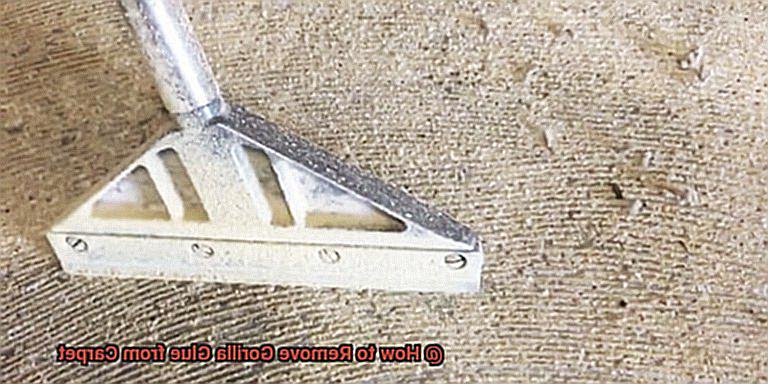
Use a Drop Cloth or Old Towel
Before using Gorilla Glue, place a drop cloth or an old towel under your working area. This will catch any drips or spills that may occur, preventing them from reaching your carpet.
Keep Children and Pets Away
Children and pets are naturally curious and tend to touch everything they see. Keep them away from the area where you are using Gorilla Glue to prevent any accidental spills. This will not only protect them from harm but also protect your carpet from damage.
Store the Glue Properly
Always store the Gorilla Glue in a cool, dry place away from direct sunlight, heat sources, and moisture. This will help preserve its quality and prevent any leaks or spills.
Use Protective Gear
Wear gloves and protective eyewear while using Gorilla Glue. This will not only protect your skin and eyes but also prevent any accidental spills on your clothes or carpet.
By following these simple tips, you can prevent future spills of Gorilla Glue on your carpet, saving yourself time and money in the long run. Remember to handle the glue with care and have a clean-up kit ready in case of any spills. With these precautions, you can ensure that your carpet stays clean and in good condition.
Li3_SpYup18″ >
Conclusion
In summary, removing Gorilla Glue from carpet may seem like a daunting task, but with the right approach, it can be easily accomplished. Prompt action is crucial when dealing with spills since the glue gets harder to remove as it dries.
To remove excess glue, use a plastic scraper or spoon and avoid damaging the carpet fibers. Three different methods for removing Gorilla Glue from carpet include hot water and dish soap, acetone, and rubbing alcohol. However, make sure to test any cleaning solution on an inconspicuous area of your carpet first to prevent damage or discoloration.
Preventing spills of Gorilla Glue on your carpet is better than dealing with its aftermath. Be cautious while using the glue, use a drop cloth or old towel, keep children and pets away, store the glue properly, and use protective gear like gloves and eyewear.

